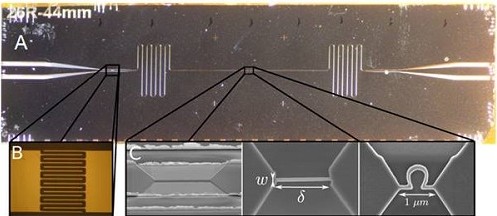
For this, a series of Nb-based coplanar waveguide (CPW) resonators are being fabricated in the PI’s laboratory. The resonator dimensions have been calculated to maximize the unloaded quality factor while maintaining a 50-Ohms impedance through a 300nm-thick Nb film deposited on a 600 um-thick Sapphire substrate. Symmetric direct and interdigitated coupling gaps separate the resonator from the feed lines, with dimensions chosen to obtain both under- and over-coupled resonators. Resonators with Q>104 and nanosconstirctions in the central line to enhance the electromagnetic field at the sample position (see figure) have already been fabricated in collaboration with the group of Fernando Luis (UZ, Spain).
The combination of the greatly enhanced coupling parameter provided by tunneling states in some mononuclear SMMs with high-Q superconducting resonators designed with nano-constrictions (see figure) may place these systems in a unique position to test the feasibility of coupling a photon cavity mode with a single molecular spin, which has never been achieved before.
Recent Works:
D. Jenkins, U. Naether, M. Ciria, J. Sesse, J. Atkinson, C. Sanchez-Azqueta, E. del Barco, Johannes Majer, David Zueco, and Fernando Luis, Nanometric constrictions in superconducting coplanar waveguide resonators, Appl. Phys. Lett. 105, 162601 (2014)
Other publications by the group
Collaborators:
Physics:
Fernando Luis (UZ, Zaragoza, Spain)
Chemistry:
Eugenio Coronado (UV, Valencia, Spain)
Selvan Demir (Michigan, US)